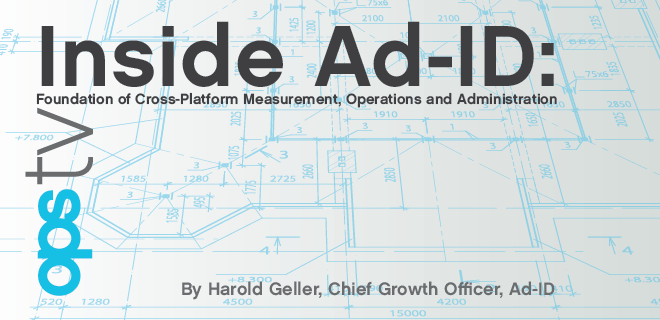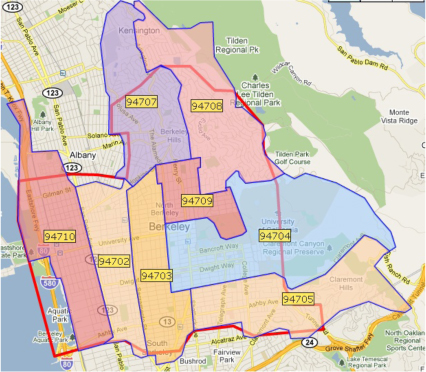
How many people here were involved in cross-platform video 10 years ago?
We had just a few media platforms there were a few thousand channel choices, and nearly all media was consumed on a linear basis.
Now, media is also consumed on an on-demand basis through a multitude of media platforms and tens of thousands of channel choices. As a result of the growth in the ways to consume media, and the explosion of “channels” our ecosystem has become more complex, and will continue to grow in complexity.
Ad-ID is like ZIP. The Postal Service saw their business grow more and more complex. The complexity was choking their ability to perform simply. Business mail, direct mail, flyers, magazines, etc., bogged them down. Sound familiar. We complain in this business about the explosion of the new media platforms.
 So as you look at this map of Berkley, California, imagine if each colored block decided to invent a way to identify themselves – one would say I’m going to have an eight-digit ZIP code. Another would say they’re going to use a variety of emoticons plus numbers. And yet another would choose to use letters and numbers and dashes and multiplication signs. All of that would go thundering through the system and jam it up, because somebody has got to figure all that stuff out.
So as you look at this map of Berkley, California, imagine if each colored block decided to invent a way to identify themselves – one would say I’m going to have an eight-digit ZIP code. Another would say they’re going to use a variety of emoticons plus numbers. And yet another would choose to use letters and numbers and dashes and multiplication signs. All of that would go thundering through the system and jam it up, because somebody has got to figure all that stuff out.
The plumbing in our ad ecosystem hasn’t kept up with the times. Imagine way back when someone told you all that ZIP was the way to go. You wouldn’t believe it because you couldn’t see it. Today its applications and use and the efficiency it causes creates value in the trillions.
I am telling you that Ad-ID is like ZIP. I can also tell you that it’s better and will help and its ultimate use will far exceed the vision today.
UPC Analogy
Ad-ID is like the UPC code. This identification concept was originally designed for grocery store checkout. After successful trial in Ohio in the late 1970s it took a while to roll out. Much education and consumer acceptance had to happen. But what really pushed this over the edge was the insistence of major retailers like K-Mart and Walmart insisting that your goods wouldn’t be carried unless they had bar codes.
Imagine if the media companies said, “Stop the madness: Only send me ads with Ad-ID.” Or conversely they penalized those that didn’t have a universally recognized code so they could deal with it efficiently.
At the core of Ad-ID is standardized descriptive information about an ad—advertiser Name, product name, commercial title, commercial length, that are being shared today, just in an analog manner.
We have support all throughout the food chain.
Ad-ID is the industry standard for identifying advertising assets (video, audio, print and display) across all media platforms. Today it has 800 users, including the largest advertisers and retailers in the world. Ad-ID is the preferred ad identification of the major TV networks, and is a joint venture of the 4As and ANA.
Ball in the Media Company Court
The adoption of AD-ID, while not bad, is not necessarily great. In fact, only 37% of video ads leverage Ad-ID.
Don’t think that the other 63% use another single system; in fact they use a variety of nonstandard, decentralized and home-grown methodologies, which force the rest of the ad food chain to compensate by creating house or proprietary identification methods.
Ad-ID is at the center of the digital commercial slate, developed by the Advanced Media Workflow Association, whose members include the major media outlet in the world, and their automation vendors.
We know that today Ad-ID does these things. We know that the media is clamoring for this. We know that the ecosystem is screaming for uniformity. To manage the ad asset we all better make sure that it has one name that the entire ad universe recognizes.
To reduce complexity, not only do all advertisers need to use Ad-ID, but the media must demand its use for all their assets, and for all their vendors to support, carry and preserve the Ad-ID through all workflows.
If we’re talking about dynamically served ads and ads across platforms, how do we compare audience delivery – and what works on each platform – if we don’t have a single identity for the same creative unit?
The life of a commercial involves many stakeholders, and the commercial is ultimately delivered in many formats to suit the needs of each platform before it reaches the multitude of consumer devices, with their myriad of format restrictions.
Ad-ID is the least expensive and smartest digital investment an advertiser can make. Margins are under pressure. Advertisers are hammered daily on prices; agencies are hammered by their clients. The ad world is still overly labor intensive, slow and patches up inadequate processes with people.
As operations specialists, you all know about cross-platform complexity. When I speak to advertisers about why they don’t adopt Ad-ID, the no. 1 response I get is that the media and their vendors are not asking for unique codes – they’ll accept anything we give them.
What I’m asking you to do is to start advocating for simplicity, tell your customers that unique advertising asset identification matters to you. Tell them to provide you with valid Ad-ID codes.
Note: This is a modified version of the presentation Geller gave at OPS TV on July 11, 2012.
 |
Macro-level changes are coming, and you can sieze the opportunities that follow at OPS NY. This event will bring together digital advertising leaders and ops professionals to discuss a rapidly evolving landscape and develop strategies for monetization. Register today for OPS NY which will be held Oct. 4, 2012. |